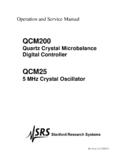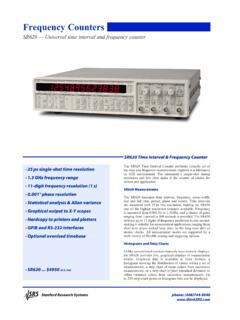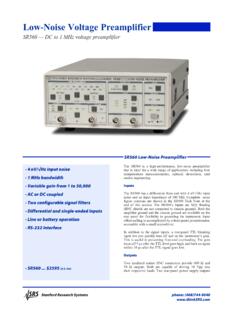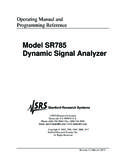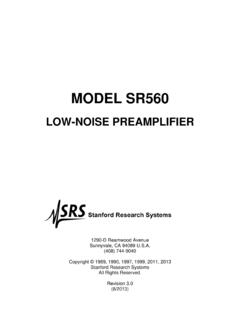Transcription of Model DS360 Ultra Low Distortion Function Generator
1 DS360 Ultra Low Distortion Function Generator Revision (06/2018) Operating Manual and Programming Reference Model DS360 Ultra Low Distortion Function Generator 1290-D Reamwood Avenue Sunnyvale, CA 94089 Phone: (408) 744-9040, Fax: (408) 744-9049 email: Copyright 1999, 2007, 2008, 2011, 2012, 2013, 2016, 2018 by SRS All Rights Reserved Certification Stanford Research Systems certifies that this product met its published specifications at the time of shipment. Stanford Research Systems further certifies that its calibration measurements are traceable to the United States National Institute of Standards and Technology (NIST).
2 Warranty This Stanford Research Systems product is warranted against defects in materials and workmanship for a period of one (1) year from the date of shipment. Service For warranty service or repair, this product must be returned to a Stanford Research Systems authorized service facility. Contact Stanford Research Systems or an authorized representative before returning this product for repair. Information in this document is subject to change without notice. Copyright Stanford Research Systems, Inc., 1999, 2007, 2008, 2011, 2012, 2013, 2016, 2018. All rights reserved. Stanford Research Systems, Inc.
3 1290-D Reamwood Avenue Sunnyvale, California 94089 Printed in USA i DS360 Ultra Low Distortion Function Generator Safety and Preparation for Use WARNING! Dangerous voltages, capable of causing injury or death, are present in this instrument. Use extreme caution whenever the instrument is cover is removed. Do not remove the cover while the unit is plugged in to a live outlet. Caution This instrument may be damaged if operated with the LINE VOLTAGE SELECTOR set for the wrong AC line voltage, or if the wrong fuse is installed. Line Voltage Selection The DS360 operates from a 100, 120, 220 or 240 Vrms AC power source having a line frequency of 50 or 60 Hz.
4 Before connecting the power cord to a power source, verify that the LINE VOLTAGE SELECTOR, located in the rear panel fuse holder, is set so that the correct AC input voltage is visible. Conversion to other AC input voltages requires a change in the fuse holder voltage card position and fuse value. Disconnect the power cord, open the fuse holder cover door and rotate the fuse-pull lever to remove the fuse. Remove the small printed circuit board and select the appropriate operating voltage by orienting the printed circuit board so that the desired voltage is visible when pushed firmly into its slot.
5 Rotate the fuse-pull lever back into its normal position and insert the correct fuse into the fuse holder. Line Fuse Verify that the correct fuse is installed before connecting the line cord. For 100/120 VAC, use two Amp fuses and for 220/240 VAC use two Amp fuses. Line Cord The DS360 has a detachable, three-wire power cord for connection to the power source and to a protective ground. The exposed metal parts of the instrument are connected to the outlet ground to protect against electrical shock. Always use an outlet which has a properly connected protective ground. Power Switch The power switch is located on the front panel of the unit, in the lower right hand corner.
6 Turn on the unit by pressing the switch in. Fan The fan in the DS360 is required to maintain proper operation. Do not block the vents in the chassis or the unit may not operate properly. ii DS360 Ultra Low Distortion Function Generator Table of Contents iii DS360 Ultra Low Distortion Function Generator Table of Contents Safety and Preparation For Use i Table of Contents iii Table of Figures v Specifications vii Abridged Command List xi Chapter 1 Getting Started Front Panel Operation 1-3 Continuous Waveforms 1-4 Frequency Sweeps 1-5 Tone Bursts 1-6 Chapter 2 Basics Introduction 2-3 Front Panel Features 2-5 Rear Panel Features 2-12 Chapter 3 Operation Power On 3-3 Setting functions 3-4 Output Configuration 3-9 Modify functions 3-11
7 Instrument Setup 3-18 Troubleshooting 3-21 Chapter 4 Programming Index of Commands 4-2 Introduction 4-5 Command Syntax 4-8 Function Output Commands 4-9 Modify Function Commands 4-12 Setup Control Commands 4-15 Status Reporting Commands 4-16 Hardware Test and Calibration Commands 4-17 Status Byte Definition 4-19 Example Programs 4-21 Chapter 5 Testing Getting Ready 5-3 Front Panel Test 5-7 Self Test 5-8 Frequency Test 5-9 Amplitude Test 5-10 Harmonic Distortion 5-13 Waveform Test 5-15 Sweep Test 5-17 iv Table of Contents DS360 Ultra Low Distortion Function Generator Burst Test 5-18 DC Offset Test 5-19 Output Impedance Test 5-21 DS360 Performance Test Record 5-23 Chapter 6 Circuitry Overview 6-3 Digital Board Description 6-3 Analog Board Description 6-6 Front Panel Description 6-9 Programmable Resistor Board Description 6-9 Digital Board Parts List 6-11 Analog Board Parts List 6-15 Front Panel Parts List 6-27 Distortion Filter Parts List 6-31 Miscellaneous and Chassis Parts List 6-32 Digital Board Schematics DIG-1 to DIG-7 Analog Board Schematics ANA-1 to ANA-7 Front Panel Schematics FP-1 to FP-2 Programmable Resistor Board Schematics PROGR1 Table of Contents v
8 DS360 Ultra Low Distortion Function Generator Table of Figures Figure 2-1 Block Diagram 2-4 Figure 2-2 Front Panel 2-5 Figure 2-3 Keypad 2-6 Figure 2-4 Outputs 2-8 Figure 2-5 Indicators 2-9 Figure 2-6 Display 2-10 Figure 2-7 Rear Panel 2-12 Figure 2-8 Rear Outputs 2-13 Figure 5-1 Distortion Filter 5-5 vi Contents DS360 Ultra Low Distortion Function Generator Specifications vii DS360 Ultra Low Distortion Function Generator Specifications Waveforms Sine Frequency Hz to kHz THD 1 VRMS Unbalanced, 2 VRMS Balanced Frequency Typical Maximum Hz - kHz < -110 dB -106 dB kHz - kHz < -104 dB -100 dB kHz - kHz < -100 dB -96 dB kHz - kHz < -90 dB -85 dB kHz - kHz < -76 dB -68 dB THD 10 VRMS Unbalanced.
9 20 VRMS Balanced Frequency Typical Maximum Hz - kHz < -109 dB -105 dB kHz - kHz < -103 dB -99 dB kHz - kHz < -98 dB -93 dB kHz - kHz < -88 dB -83 dB kHz - kHz < -76 dB -68 dB Square Frequency Hz to 200 kHz Rise Time s Even Harmonics <-60dBc (to 20 kHz) White Noise Bandwidth DC to 200 kHz Flatness < dB pk-pk, 1 Hz to 100 kHz Crest Factor 11 dB Pink Noise Bandwidth 10 Hz to 200 kHz Flatness < dB pk-pk, 20 Hz - 20 kHz (measured using 1/3 octave analysis) Crest Factor 12 dB Bandwidth Limited Noise Bandwidth 100 Hz, 200 Hz, 400 Hz, 800 Hz, kHz, kHz, kHz, kHz, kHz, kHz, kHz Center Frequency 0 Hz to kHz, 200 Hz increments Flatness (in band) < dB pk-pk Crest Factor Base Band (0 Hz Center Freq)
10 12 dB Non Base Band 15 dB viii Specifications DS360 Ultra Low Distortion Function Generator Two-Tone Type Sine-Sine, Sine-Square Sine Frequency Hz to kHz Square Frequency Hz to kHz Square Resolution 2 digits SFDR >90 dB Sine or Square Burst ON Cycles 1/2, 1 to 65534 cycles Repetition Rate 1 to 65535 cycles Triggering Internal, External, Single, Externally Gated OFF Level % - % (of ON Level) OFF Resolution % Max OFF Attenuation 1 kHz -90 dBc 10 kHz -70 dBc 100 kHz -50 dBc White or Pink Noise Bursts ON Time 10 s - Repetition Time 20 s - 600s Triggering Internal, External, Single, Externally Gated OFF Level - (of ON Level) Resolution Sine or Square Sweeps Type Linear or Logarithmic Range Hz to kHz Rate Hz to kHz Resolution 2 digits Flatness dB (1%) Frequency Resolution (unless otherwise specified) 6 digits or 1 mHz, whichever is larger Accuracy 25 ppm ( ) + 4 mHz from 20 to 40 C Amplitude Unbalanced Output (+ output only)

